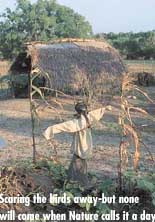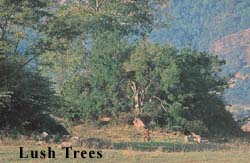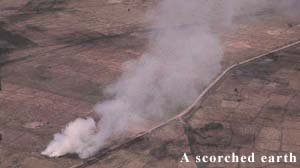 |
 19th July 1998 |
Front Page| |
Studio Times Series - Part 11
The great land grab"Essentially, we have divided our country in two, between the kingdom of wilderness and the kingdom of the market. I suppose we should be grateful for secure borders. But what do those of us who care about nature do when we're on the market side, which is most of the time? How do we behave? What are our goals? We can't reasonably expect to change the borders... Faced with hard questions about how to confront global environmental problems, adherents of the wilderness ethic are apt to throw their hands in despair and declare the "end of Nature"." Michael Pollan, Second Nature: A Gardener's Education By Charith PelpolaFor years, the warnings of ecological collapse and environmental fatigue have fallen largely on deaf ears in Asia. So today soil degradation is what we have been left with, after the combined ravages of deforestation, intensive agriculture, overgrazing by domesticated herds, and over-exploitation of natural resources have run their course.
This steady movement of people has been taking place predominantly in the dry-land belt in the south of the island. A transition zone between forest and scrubland habitats, it is now under increasing stress from land use and climate variability, brought about by human activity. Persistent, unchecked land damage claims both soil and vegetation, leaving little habitat for the region's wildlife. This fate might soon befall Kalametiya. A sanctuary for migratory and resident bird populations, farmers have already tilled the poor soil, growing maize and tubers, right under the nose of the Wildlife Department. The land is perforated with shallow trenches where shell has been mined and abandoned plots exhausted after the first crops have been cultivated. Ultimately, though they may reap a meagre harvest now, there will soon be no resources left in such fragile lands.
There is a solution to the problem. The detrimental effects of land deterioration have already worn too deeply into the island earth. The natural reserves must be maintained. Our future depends on it. But the people must also be fed and our children must grow strong. Perhaps the time has come to consider the importance of human and ecological survival and think less of the once overwhelming interest of economic profit. |
||
 |
Front Page| News/Comment| Editorial/Opinion| Business| Sports | Mirror Magazine |
|
 |
Please send your comments and suggestions on this web site to |
|
 The
results of land degradation often force people to abandon their farms and
homes. This is the fate of many subsistence farmers in Sri Lanka, who eventually
find themselves settling in protected reserves and cultivating on protected
soil. They have in effect become "ecomigrants" scouring the country
for better land and healthier lives elsewhere.
The
results of land degradation often force people to abandon their farms and
homes. This is the fate of many subsistence farmers in Sri Lanka, who eventually
find themselves settling in protected reserves and cultivating on protected
soil. They have in effect become "ecomigrants" scouring the country
for better land and healthier lives elsewhere. Poor
land management, inadequate technology, overpopulation, poverty and certain
decisions of social and political structures, all take their toll on the
land. One can't necessarily blame the farmer or the fisherman for casting
envious eyes upon burgeoning forests and lush grasslands. Unlike multinational
corporations, their only interest in protected land is as a means of feeding
their starving families. And unlike sugar corporations and timber merchants,
they don't hold much influence over the politician or the foreign investor.
Their voices are never heard, so they act on instinct and desperation.
Poor
land management, inadequate technology, overpopulation, poverty and certain
decisions of social and political structures, all take their toll on the
land. One can't necessarily blame the farmer or the fisherman for casting
envious eyes upon burgeoning forests and lush grasslands. Unlike multinational
corporations, their only interest in protected land is as a means of feeding
their starving families. And unlike sugar corporations and timber merchants,
they don't hold much influence over the politician or the foreign investor.
Their voices are never heard, so they act on instinct and desperation. Landscapes
throughout the world undergo transformation processes that include some
form of natural degradation, but these processes are usually compensated
for and counterbalanced by nature's inherent recovery potential. But the
danger is when degradation processes significantly exceed nature's restorative
capacity. Only human intervention could disturb such a balance, taking
more from the environment than we could ever hope to replenish.
Landscapes
throughout the world undergo transformation processes that include some
form of natural degradation, but these processes are usually compensated
for and counterbalanced by nature's inherent recovery potential. But the
danger is when degradation processes significantly exceed nature's restorative
capacity. Only human intervention could disturb such a balance, taking
more from the environment than we could ever hope to replenish.